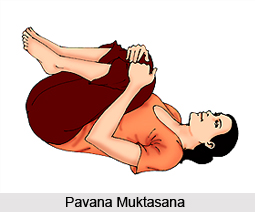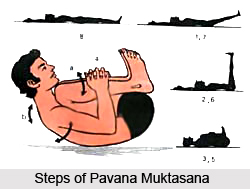 Pavana Muktasana also called `wind removing pose` is a widely practised asana. Easy to execute and helpful for gastric patients, pavana muktasana is an important practice in the body of Hatha Yoga techniques. This asana helps to maintain general health, youthfulness and vitality.
Pavana Muktasana also called `wind removing pose` is a widely practised asana. Easy to execute and helpful for gastric patients, pavana muktasana is an important practice in the body of Hatha Yoga techniques. This asana helps to maintain general health, youthfulness and vitality.
Meaning of Pavana Muktasana
Pavana muktasana is a Sanskrit word, where `pavana` refers to `wind` or `gaseous form of matter`. Mukta or mukti means `liberation` or `release`, which makes this asana the `wind release pose`. It is precisely the accumulation of `wind` or `air` within the body that leads to dysfunction, degeneration of the tissues, and aging. The severity of such problems leads to gastric ulcer and cancers in stomach. Pavana mukta asana provides relief to this `gaseous condition`, and is a great healer if practiced regularly.
The steps of Pavana Muktasana
•Firstly, one should lie on the back with the legs out straight.
•Then he/ she should inhale as the person deeply hugs the right knee on the right side of the chest.
•If possible, using the abdominal muscles, one has to bring the nose to the level of the knee.
•The extended leg must remain active, with foot flexed.
•One has to exhale back down to the floor and repeat on the left side.
•This should be done five times total on each side.

Benefits of Pavana Muktasana
•The warmth and pressure created after doing pavana muktasana, releases bloating and entrapped glass, first in the ascending colon (right side) and then in the descending colon (left side).
•This asana helps in curing acidity, indigestion and constipation.
•It is helpful for those suffering from arthritis pain, heart problems and waist pain.
•It is beneficial for reproductive organ and for menstruation disorder.
•It strengthens back muscle and cures back pain.
Precaution about Pavana Muktasana
•People suffering from high blood pressure, slip disc, and ulcer should avoid this asana.
•Also in pregnancy and menstruation women should not practice this.
•Those who have an injury in the spine or sciatica should not practice this asana.
•Do not practice this asana on a full stomach.




















